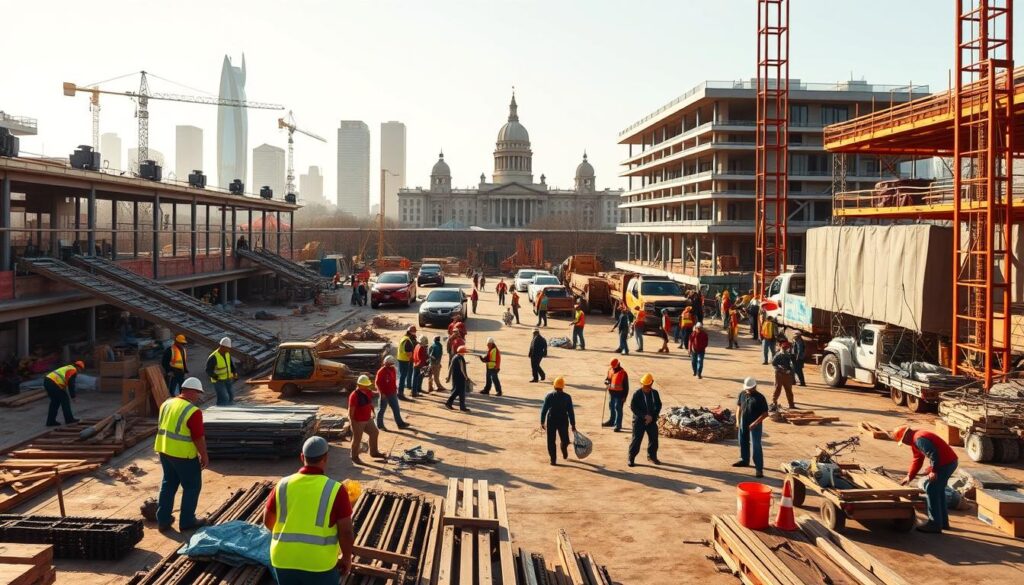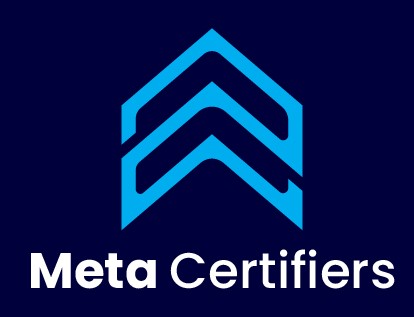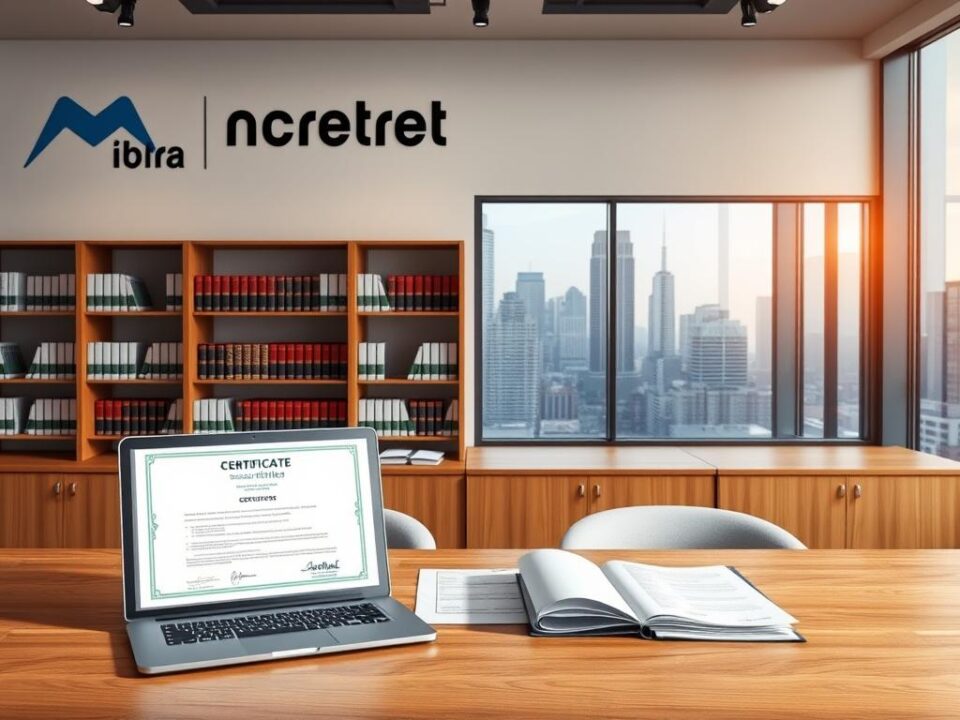What is the Long Service Levy?
The NSW Government charges a levy on building and construction works valued at $250,000 or more. This long service levy is paid into a fund administered by the Long Service Corporation (LSC), which provides long service benefits to eligible workers in the building and construction industry.
I will outline the importance of this levy in supporting workers in an industry characterized by short-term employment. Recent changes to the levy, including a reduction from 0.35% to 0.25% and an increased threshold from $25,000 to $250,000 as of January 2023, have significant implications for construction projects.
Key Takeaways
- The Long Service Levy is a statutory payment required for NSW construction projects valued at $250,000 or more.
- The levy is administered by the Long Service Corporation (LSC) to provide long service benefits to eligible workers.
- Recent changes to the levy include a reduced rate and increased threshold.
- The levy supports workers in the building and construction industry.
- The fund administered by the LSC provides portable long service benefits.
Understanding the Long Service Levy in NSW

In NSW, the Long Service Levy plays a vital role in supporting workers in the building and construction industry. The levy is a critical component of the industry’s regulatory framework, ensuring that workers receive long service benefits.
The Legislative Framework
The Long Service Levy is governed by specific legislation, primarily the Building and Construction Industry Long Service Payments Act 1986. This Act, along with the Local Government Act, defines the types of building and construction work the levy applies to.
Building and Construction Industry Long Service Payments Act 1986
The Building and Construction Industry Long Service Payments Act 1986 is a key piece of legislation that outlines the levy requirements. The Act ensures that workers in the construction industry receive long service benefits, providing them with financial security after a certain period of service.
The levy applies to various types of building work, including major projects and infrastructure, civil construction such as roads and bridges, fuel, gas and water storage facilities, residential building, sewage, drainage and water treatment systems, telecommunications, and electrical distribution infrastructure.
By understanding the legislative framework and the types of work covered by the levy, builders and contractors can ensure compliance and support the long service benefits of workers in the NSW construction industry.
Who Needs to Pay the Long Service Levy?
Understanding who is responsible for paying the Long Service Levy is crucial for compliance in the construction industry. The levy is a critical financial component that supports workers’ entitlements in NSW.
Determining Responsibility for Payment
The responsibility for paying the Long Service Levy typically falls on the applicant of the building approval or the person for whom the work is being completed. This means that individuals or entities commissioning building work are generally liable for the levy.

There are exceptions to this general rule. For instance, when building work is done on behalf of the Crown, the contractor is usually responsible for paying the levy. Additionally, different rules apply if the work is carried out by a body established by an act of parliament, such as a Council. It’s also important to note that work conducted on Commonwealth places is not covered under the NSW Building and Construction Industry Long Service Payments Act, as these fall under federal jurisdiction.
Contractors often factor the levy into their project quotes, so it’s essential to understand these dynamics to avoid non-compliance. Failure to pay the levy can result in fines, penalties, or prosecution, emphasizing the need for clarity on who bears the financial responsibility in various construction scenarios.
Current Long Service Levy Rates and Calculations
As of the latest update, the Long Service Levy rate stands at 0.25% for eligible construction projects.
The Long Service Levy is calculated based on the cost of building and construction works. Currently, the levy rate is 0.25% of the total cost of projects valued at $250,000 or more, including GST. This represents a change from the previous rate of 0.35%, which applied to projects valued at $25,000 or more before 31 December 2022.
How to Calculate Your Levy Payment
To calculate your Long Service Levy payment, you need to consider the total project cost, including GST. The formula is straightforward: Levy Amount = Total Project Cost (including GST) * Levy Rate. For instance, if your project’s total cost is $500,000, the levy amount would be $500,000 * 0.25% = $1,250.
Using the Official Levy Calculator
For a more precise calculation, especially for complex projects, you can use the official Long Service Corporation levy calculator. This tool is designed to help you determine the exact amount you need to pay for each job. To use the calculator, simply input your project’s total cost, and it will calculate the levy amount based on the current rate.
- The current Long Service Levy rate is 0.25% for projects valued at $250,000 or more, including GST.
- The levy rate changed from 0.35% to 0.25% on 31 December 2022, with the threshold increasing from $25,000 to $250,000.
- The levy is calculated based on the total project cost, including GST, to ensure compliance with the regulations.
It’s essential to note that while the levy payment itself does not attract GST, the calculation should be based on the GST-inclusive cost of the construction work. This ensures that your levy payment is accurate and compliant with the current regulations.
When and How to Pay the Long Service Levy

Before commencing any building work in NSW, it’s essential to understand how to pay the Long Service Levy. The levy must be paid before any construction work begins, as stipulated by NSW regulations.
Payment Methods and Timing
The Long Service Levy can be paid through various methods, ensuring convenience for individuals and companies. You can pay online using Visa, Mastercard, PayPal, or PayID. Alternatively, you can use BPay, although this may take up to three days to process. In-person payments are also accepted at participating local councils; it’s advisable to contact your council to confirm their participation. For direct payments to the Long Service Corporation (LSC), you can use Electronic Funds Transfer (EFT) upon request.
It’s crucial to note that a council or accredited certifier can only release your Construction Certificate (CC) or Complying Development Certificate (CDC) after the levy is paid. This means that payment of the levy is a prerequisite for obtaining the necessary certificates to commence building work.
Creating a Long Service Corporation Account
Companies and organisations can create a Long Service Corporation account using their Australian Business Number (ABN). This account allows for streamlined management of multiple projects and levy payments. Individuals can also create an account using MyServiceNSW, facilitating easy access to their levy payment history and other related services.
Proper documentation of levy payments is essential for record-keeping and compliance purposes. Ensuring that you have the necessary receipts and records will help you demonstrate compliance with NSW regulations.
Exemptions and Reductions Available
It’s essential to know that some individuals and organisations may qualify for a reduction or exemption from the Long Service Levy. The Long Service Levy has provisions to support certain groups, including owner-builders and non-profit organisations.
Partial Exemptions for Owner-Builders
Owner-builders who hold an Owner Builder Permit issued by NSW Fair Trading may be entitled to a reduction in the levy amount. For projects costing less than $500,000 with a voluntary labour component of less than 50%, exemptions are processed automatically. This can result in a significant reduction, up to 50%, in the long service levy payable.
Churches and Non-Profit Organisations
Churches and non-profit organisations may also be eligible for a reduction in the Long Service Levy based on the voluntary labour component of their construction projects. To qualify, they must apply within 12 months of the original levy payment. The maximum discount available is 50%, and the minimum levy payable is $50.
Applications for partial exemptions must be supported by relevant documentation, which will be reviewed by the Long Service Corporation. By understanding these exemptions, individuals and organisations can potentially reduce their long service levy burden.
Refunds and Additional Payments
Navigating the Long Service Levy involves understanding the conditions under which you may be eligible for refunds or required to make additional payments.
Eligibility for Refunds
You may be eligible for a full or partial refund of the Long Service Levy under certain circumstances. For instance, if the work did not commence and the building approval lapsed or was cancelled, you may be eligible for a refund. Similarly, if there was a duplication or overpayment of the levy, you can apply for a refund. Additionally, if you paid the levy in full but are entitled to a partial exemption as an owner-builder, church, or non-profit organisation, you may be eligible for a refund, provided you apply within 12 months of payment.
On the other hand, if the levy is underpaid due to incorrect cost estimates, paid late, or not paid at all, penalties or extra levies may apply. Interest on outstanding amounts may also be charged in accordance with the Building and Construction Industry Long Service Payments Act 1986 and the Building and Construction Industry Long Service Payments Regulation 2022. The interest rate is set at 6% above the cash rate published by the Reserve Bank of Australia.
It’s crucial to manage your levy payments carefully to avoid additional charges. If project costs change significantly during construction, you may need to make additional levy payments or potentially qualify for a partial refund. Understanding these dynamics can help you navigate the Long Service Levy scheme more effectively.
Benefits of the Long Service Levy Scheme
By providing a portable long service benefit, the Long Service Levy Scheme addresses the unique challenges faced by the construction industry’s transient workforce. This scheme is crucial for ensuring that eligible workers receive their long service leave entitlements after a continuous 10-year period in the industry.
Advantages for Workers
The Long Service Levy Scheme offers several benefits to workers in the building construction industry. Some of the key advantages include:
- Access to long service leave entitlements after 10 years, regardless of the number of employers they’ve worked for.
- The ability to track their service and claim entitlements when eligible.
- A secure and portable benefit that moves with them as they change jobs or employers.
Benefits for Employers and the Industry
Employers also benefit significantly from the Long Service Levy Scheme. The scheme allows them to outsource the management of long service leave, creating a level playing field across the industry. This contributes to the overall stability and sustainability of the construction industry by supporting worker retention and recognizing long-term contributions.
How Meta Certifiers Can Help with Your Building Approval Process
As you navigate the complexities of the Long Service Levy, expert guidance can make all the difference in your building project. Meta Certifiers Pty Ltd is a team of expert building consultants and private certifiers with extensive knowledge of NSW building regulations, including Long Service Levy requirements.
We assist clients in determining whether their construction projects are subject to the Long Service Levy and calculating the correct amount payable. Our services also include guidance on obtaining Construction Certificates and Complying Development Certificates, ensuring that your project complies with all regulatory requirements.
Streamlining Your Construction Certification
By working with Meta Certifiers, you can streamline the certification process, potentially saving time and preventing costly mistakes. Our expertise ensures compliance with the Long Service Levy scheme and other building regulations.
For professional assistance with your building projects, contact Meta Certifiers Pty Ltd at 1/25 Padstow Pde, Padstow NSW 2211, or via email at [email protected], or call us on 1300 740 378.





